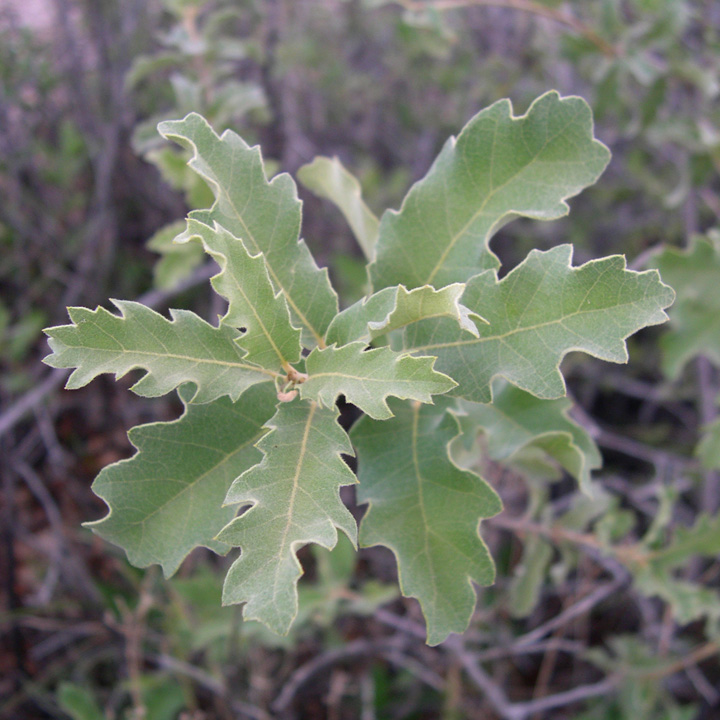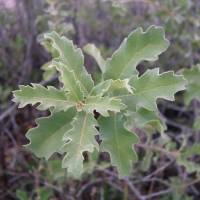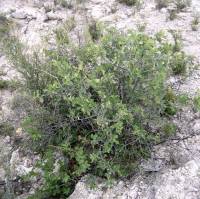Shrubs , deciduous, low, forming clones 0.3-1.5 × 10 m, rhizomatous. Bark light gray, scaly-papery. Twigs brown or grayish, 1-2.5 mm diam., glabrous or densely short grayish or yellowish tomentulose, glabrate in age. Buds dark red-brown, subglobose, ca. 2 mm, sparsely pubescent. Leaves: petiole to 7 mm. Leaf blade green, often turning brownish with age, polymorphic, oblong or elliptic or sometimes lanceolate to oblanceolate or ovate to obovate, (30-)50-100 × (10-)20-50 mm, rather thick and hard, base rounded to cuneate, margins flat to revolute, at least some undulate, 2-3 rounded teeth on each side, secondary veins 5-8 on each side, much branched, apex broadly rounded, rarely acute; surfaces abaxially densely grayish or yellowish tomentulose or stellate-pubescent, sometimes only sparsely pubescent, secondary veins quite prominent, adaxially lustrous, very sparsely stellate-pubescent or glabrate, secondary veins very slightly if at all raised. Acorns solitary or paired, subsessile or on peduncle to 10(-18) mm; cup from deeply cup-shaped to goblet-shaped, 10-12 mm deep × 15-25 mm wide, enclosing 1/3-1/2 nut, base rounded or slightly constricted, margin very thin and smooth, scales reddish brown, triangular-ovate to long-acute, proximally moderately to markedly tuberculate, pubescent, often canescent, tips loosely appressed; nut brown, ovoid, 12-25 × 14-18 mm. Cotyledons distinct.
Flowering spring. Deep, shifting or stabilized sand dunes, off deep sands in putative hybrid populations; 500-1500 m; N.Mex., Okla., Tex.
Individual clones emerging to heights of 2-3 m from thickets occur sporadically across the Texas range of Quercus havardii and express some characteristics of Q . stellata , such as more deeply lobed leaves and smaller acorns. Such putative hybrids increase in frequency in the eastern part of the range of the species.
Material of Quercus havardii from the Navajo Basin of Utah and adjacent Arizona has been treated as Q . havardii var. tuckeri Welsh. Welsh followed J. M. Tucker (1970) and interpreted these intermediate populations as putative hybrids between Q . havardii and both Q . turbinella and Q . gambelii . Giving varietal rank, instead of nothospecies status, to such populations seems arbitrary, and it certainly is inconsistent with their putative hybrid origins.
Plant: shrub; 0.5-2(-5) m high, forming patches of a few to numerous stems in sandy soils, the bark light gray, fissured; young twigs densely to moderately tawny woolly, the older twigs glabrescent within about 2 years, light chalky gray or less often reddish-brown
Leaves: lobed, elliptic to obovate, 2.5-7.5 cm long, 1.2-5.5 cm wide, 1.3-2.8 times as long as wide, densely woolly below, moderately woolly above, persisting from spring to autumn, the lobes 3-6 per side, the sinuses reaching to ca. 50% of the way to the midvein; stellate hairs of lower leaf surface with 8-13 arms; apex acute, obtuse, or truncate; base acute to subcordate, sometimes oblique; petiole 2-10 mm long, densely woolly; midvein raised to nearly flat above, prominent below; lateral veins nearly flat above, raised below; secondary veins forming a reticulate pattern, obscured by hairs below; blade leathery, usually dull above; margin aside from lobes entire or coarsely toothed, nearly flat to strongly undulate, the apices of the lobes and teeth often weakly spinescent
INFLORESCENCE: staminate flowers in aments; pistillate flowers solitary or in groups on spikes, these sometimes abbreviated, each pistillate flower with a separate involucre
Flowers: mostly wind-pollinated, unisexual, the perianth much reduced or absent; staminate flowers in heads or aments, the perianth greenish, the stamens ca 8; pistillate flowers usually tricarpellate, solitary or in clusters of about 3 or more, subtended individually or in groups by an involucre that develops into a woody cupule enclosing or subtending the mature fruit(s)
Fruit: ACORNS 1.5-3 cm long, solitary or in pairs; cap hemispheric to plate-like, 5-15 mm long, 12-25 mm wide, the inner surface densely woolly; scales with thickened bases; nut-shell glabrous to subglabrous within
Misc: Pinyon-juniper or blackbrush scrub in light, sandy soils; 1600-2050 m (5200-6800 ft); (fr. Jul-Aug)
Notes: soil tends to form dunes around the bases of the plant as high as 2 m
REFERENCES: Landrum, Leslie R. Fagaceae. 1994. J. Ariz. - Nev. Acad. Sci. Volume 27, 203-214





